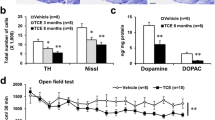Abstract.
Acute carbon monoxide (CO) intoxication in humans results in motor deficits, which resemble those in Parkinson's disease, suggesting possible disturbance of the central dopaminergic (DAergic) neuronal system by CO exposure. In the present study, therefore, we explored the effects of CO exposure on the DAergic neuronal system in the striatum of freely moving rats by means of in vivo brain microdialysis. Exposure of rats to CO (up to 0.3%) for 40 min caused an increase in extracellular dopamine (DA) levels and a decrease in extracellular levels of its major metabolites, 3,4-dihydroxyphenylacetic acid (DOPAC) and homovanillic acid (HVA), in the striatum depending on the CO concentration. Reoxygenation following termination of the CO exposure resulted in a decline of DA to the control level and an overshoot in the recovery of DOPAC and HVA to levels higher than the control. A monoamine oxidase type A (MAO-A) inhibitor, clorgyline, significantly potentiated the CO-induced increase in DA and completely abolished the subsequent overshoot in the recovery of DOPAC and HVA. Tetrodotoxin, a Na+ channel blocker, completely abolished both the CO-induced increase in DA and the overshoot of DOPAC and HVA. A DA uptake inhibitor, nomifensine, strongly potentiated the CO-induced increase in DA without affecting the subsequent overshoot of DOPAC and HVA. Clorgyline further potentiated the effect of nomifensine on the CO-induced increase in DA, although a slight overshoot of DOPAC and HVA appeared. These findings suggest that (1) CO exposure may stimulate Na+-dependent DA release in addition to suppressing DA metabolism, resulting in a marked increase in extracellular DA in rat striatum, and (2) CO withdrawal and subsequent reoxygenation may enhance the oxidative metabolism, preferentially mediated by MAO-A, of the increased extracellular DA. In the light of the neurotoxicity of DA per se and reactive substances, such as quinones and activated oxygen species, generated via DA oxidation, the significant modification of the striatal DAergic neuronal system by CO exposure might participate in the neurological outcome following acute CO intoxication.
Similar content being viewed by others
Author information
Authors and Affiliations
Additional information
Electronic Publication
Rights and permissions
About this article
Cite this article
Hara, S., Mukai, T., Kurosaki, K. et al. Modification of the striatal dopaminergic neuron system by carbon monoxide exposure in free-moving rats, as determined by in vivo brain microdialysis. Arch Toxicol 76, 596–605 (2002). https://doi.org/10.1007/s00204-002-0385-z
Received:
Accepted:
Issue Date:
DOI: https://doi.org/10.1007/s00204-002-0385-z




